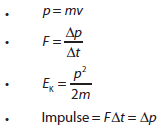|
Nature of science:
The concept of momentum and the principle of momentum conservation can be used to analyse and predict the outcome of a wide range of physical interactions, from macroscopic motion to microscopic collisions. (1.9)
|
Understandings:
- Newton’s second law expressed in terms of rate of change of momentum
- Impulse and force–time graphs
- Conservation of linear momentum
- Elastic collisions, inelastic collisions and explosions
Applications and skills:
- Applying conservation of momentum in simple isolated systems including (but not limited to) collisions, explosions, or water jets
- Using Newton’s second law quantitatively and qualitatively in cases where mass is not constant
- Sketching and interpreting force–time graphs
- Determining impulse in various contexts including (but not limited to) car safety and sports
- Qualitatively and quantitatively comparing situations involving elastic collisions, inelastic collisions and explosions
|
International-mindedness:
- Automobile passive safety standards have been adopted across the globe based on research conducted in many countries
Theory of knowledge:
- Do conservation laws restrict or enable further development in physics?
Utilization:
Martial arts
- Particle theory and collisions (see Physics sub-topic 3.1)
|
Guidance:
- Students should be aware that F = ma is equivalent of F = ∆p only when mass ∆t is constant
- Solving simultaneous equations involving conservation of momentum and energy in collisions will not be required
- Calculations relating to collisions and explosions will be restricted to one- dimensional situations
- A comparison between energy involved in inelastic collisions (in which kinetic energy is not conserved) and the conservation of (total) energy should be made
Data booklet reference:

|
Aims:
- Aim 3: conservation laws in science disciplines have played a major role in outlining the limits within which scientific theories are developed
- Aim 6: experiments could include (but are not limited to): analysis of collisions with respect to energy transfer; impulse investigations to determine velocity, force, time, or mass; determination of amount of transformed energy in inelastic collisions
- Aim 7: technology has allowed for more accurate and precise measurements of force and momentum, including video analysis of real-life collisions and modelling/simulations of molecular collisions
|


